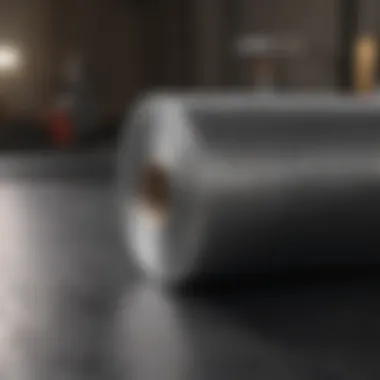Exploring Stainless Steel Hardware Cloth Benefits


Intro
Stainless steel hardware cloth represents a significant advance in materials used for various applications across industries. Its robust nature and versatility make it a preferred choice in both domestic and industrial settings. This article delves into the essential characteristics of stainless steel hardware cloth, emphasizing its advantages and a wide range of applications. It seeks to provide comprehensive knowledge that not only benefits professionals but also engages hobbyists and educators interested in construction, gardening, and pest control.
The unique properties of stainless steel hardware cloth include high strength, corrosion resistance, and durability, making it ideal for diverse usages. This material presents practical solutions for many problems, from building protective barriers to creating effective garden beds and pest control systems. By examining the specifications and features of stainless steel hardware cloth, readers will recognize its significance and inherent value within various fields.
Prolusion to Stainless Steel Hardware Cloth
Stainless steel hardware cloth is a material often overlooked, but it is widely appreciated across various industries for its unique functionalities. Its importance stems from its versatility and durability, which makes it an essential choice for many applications. Whether it's for construction purposes, pest control, or creating enclosures in gardens, stainless steel hardware cloth offers several benefits that cannot be matched by other materials.
Definition and Composition
Stainless steel hardware cloth generally refers to a wire mesh made from a specific grade of stainless steel. This material is composed of various grades of stainless steel, with 304 and 316 being the most common. The 304 grade contains about 18% chromium and 8% nickel, offering good corrosion resistance. Meanwhile, the 316 grade includes molybdenum, enhancing its strength against chlorine and other harsh environments. The wire itself comes in various thicknesses and mesh sizes, which allows for versatility depending on the intended use.
Manufacturing Process
The manufacturing process of stainless steel hardware cloth involves several steps. Initially, stainless steel wires are drawn to achieve the desired diameter. Then, these wires are woven through a process that forms a grid-like structure. The process can involve either a plain weave or a twill weave, depending on the required strength and application. Finally, the finished product is cut to various dimensions and can be coated or treated for additional protection, further enhancing its lifespan. The meticulousness of this manufacturing method ensures that the final product meets the highest quality standards, suitable for industrial and residential uses alike.
"Stainless steel hardware cloth is a testament to durability and strength, making it an invaluable resource for both professionals and homeowners."
The functional design and sturdy composition of stainless steel hardware cloth lend it to multiple applications, making it a prime candidate in a range of fields. Understanding its properties, manufacturing process, and versatility is crucial for anyone looking to utilize this material effectively.
Properties of Stainless Steel Hardware Cloth
The significance of understanding the properties of stainless steel hardware cloth cannot be overstated. These properties contribute not only to the material's performance but also to its suitability for various applications. Knowing these attributes can guide purchasing decisions and implementation strategies for both professionals and DIY enthusiasts. Key properties include corrosion resistance, strength and durability, and mesh size. Each of these elements plays a vital role in the efficacy of stainless steel hardware cloth in diverse settings.
Corrosion Resistance
Corrosion resistance is one of the most crucial properties of stainless steel hardware cloth. Stainless steel, by its composition, contains chromium which forms a protective layer of chromium oxide when exposed to oxygen. This layer naturally protects the metal from rust and degradation. In applications where the materials are exposed to moisture or environmental elements, like weather or chemicals, this property becomes especially important. For instance, in gardening or landscaping uses, stainless steel hardware cloth ensures that your installations remain intact and functional over an extended period.
Strength and Durability
Stainless steel hardware cloth is known for its exceptional strength and durability. Compared to alternatives like plastic or aluminum mesh, stainless steel offers greater tensile strength. This makes it less likely to bend, break, or deform under stress. In construction applications, for example, it provides a robust framework that supports structural integrity. Moreover, when used in pest control, its durability means that it can withstand the attempts of animals or critters trying to penetrate barriers. This resistance directly correlates with a decreased need for frequent replacements, ultimately saving time and money in the long term.
Mesh Size and Its Implications
The mesh size of stainless steel hardware cloth is another critical factor that affects its application. Varying mesh sizes allow for different uses. For example, a finer mesh may be suitable for small animals or insects, while a larger mesh can effectively serve as a barrier for larger pests. Understanding the specific implications of mesh size helps in selecting the right hardware cloth for intended functionality. It's also worth noting that selected mesh size could impact airflow or visibility in particular projects. Choosing the right size ensures that the material performs its intended function without compromise.
"Stainless steel hardware cloth combines the durability of stainless steel with versatility in mesh configurations, making it an essential material in various projects."
Uses of Stainless Steel Hardware Cloth
Stainless steel hardware cloth is an incredibly versatile material. Its uses span various sectors including construction, gardening, and home improvement. Each application takes advantage of the inherent qualities of stainless steel, like durability and corrosion resistance. Understanding the diverse uses can guide professionals and homeowners alike in making informed decisions.
Construction Applications
Framework for Walls
When considering a framework for walls, stainless steel hardware cloth is a popular choice. It provides structural support and acts as a barrier against unwanted elements. The key characteristic here is its strength. With this type of framework, homeowners can build walls that are not only sturdy but also resistant to environmental wear.
One unique feature of using stainless steel for frameworks is its ability to withstand moisture. This is particularly beneficial for areas with high humidity or frequent rain. However, the cost might be higher compared to other materials, which could be a consideration for budget-conscious projects.


Reinforcement in Concrete
In terms of reinforcement in concrete, stainless steel hardware cloth enhances the strength of structures. It helps prevent cracking and provides stability to poured concrete, making it a critical component in construction. The mesh size is a significant consideration, as different sizes provide varying levels of strength and support.
The main advantage of using stainless steel for concrete reinforcement is its longevity. Unlike other materials that may corrode over time, stainless steel maintains its integrity. This durability might come with a higher initial investment but can lead to significant long-term savings, as it reduces the need for replaces and repairs.
Gardening and Landscaping
Garden Fencing
Stainless steel hardware cloth is also effective for garden fencing. It protects plants from animals while allowing light and air to circulate. The main advantage is its strength against intruders like rabbits and deer. Many gardeners prefer this material due to its durability and ability to blend into the environment.
A unique feature of using stainless steel in gardens is its resistance to rust and decay. This means less maintenance and longer lifespan compared to organic fencing materials. However, its price might deter some homeowners, especially those with large garden areas.
Pest Control Solutions
For pest control solutions, stainless steel hardware cloth serves a crucial role. By creating barriers, it prevents small pests from entering gardens or storage areas. The high strength and resilience of the material make it ideal for protecting valuable crops.
The main benefit is its ability to allow air flow while keeping pests at bay. However, installation might require some skills and tools, which can be a downside for DIY enthusiasts who prefer simpler solutions.
Home Improvement Projects
Window Screens
In home improvement, stainless steel hardware cloth can be used for window screens. Its fine mesh provides protection from insects while allowing fresh air to enter. The durability of stainless steel ensures that these screens last much longer than traditional options.
The unique feature here is the aesthetic appeal. Stainless steel can enhance the overall look of a home while providing functionality. On the downside, the appearance of metal screens might not fit every architectural style, leading to a decision based on personal preference.
Animal Enclosures
Finally, when it comes to animal enclosures, stainless steel hardware cloth offers a safe and secure option. It keeps pets and other small animals confined without the risk of wear or rust. This is particularly important for owners who seek durability and safety for their animals.
A key characteristic is the increased visibility it provides while maintaining security. However, installation may require additional framing, which could add complexity to the project. This aspect needs to be considered when planning enclosures.
Purchasing Stainless Steel Hardware Cloth at Home Depot
Purchasing stainless steel hardware cloth at Home Depot is crucial for anyone planning to undertake projects in construction, gardening, or pest control. This material provides durability and adaptability for various applications. When considering a purchase, it is necessary to understand the options available, weigh quality versus price, and assess user feedback. These elements enhance informed decision-making and ensure satisfaction with the chosen product.
Product Availability and Variants
Home Depot offers a broad selection of stainless steel hardware cloth. Variants differ primarily in mesh size, thickness, and roll lengths. Common mesh sizes include 1/4 inch, 1/2 inch, and 1 inch, allowing for tailored applications. Thicker options are suitable for heavy-duty tasks, while thinner meshes cater to delicate needs.
Careful selection based on specific project requirements is essential. When assessing availability, consider seasonal factors, as certain products may be in higher demand during specific months. Checking stock online before visiting the store is also advisable.
Evaluating Quality and Price
Quality and price are critical factors in the purchase process. High-quality stainless steel hardware cloth typically shows resistance to corrosion and maintains integrity over time. Lower-priced options may tempt buyers but can lead to additional costs if they require frequent replacement.
To evaluate quality:
- Look for austenitic stainless steel types, such as 304 or 316, known for their corrosion resistance.
- Check material thickness; a sturdier cloth holds up better in harsh conditions.
- Read specifications carefully when comparing prices across different brands.
Finding the right balance between affordability and quality ensures long-term satisfaction with your purchase.


Customer Reviews and Insights
Customer reviews at Home Depot provide valuable insights into the performance and usability of stainless steel hardware cloth. Reading these reviews helps uncover real-world experiences. Positive feedback often highlights durability, ease of installation, and effectiveness in specific applications. However, critical reviews may address issues like unexpected rust or inadequate sizes.
It's essential to consider the volume of reviews as well. Products with numerous ratings often reflect a broader consensus on quality. Ratings can also help identify potential problems early and guide better choices. In addition to product details, insights from previous buyers can significantly impact the purchasing decision, ensuring confidence in the material selected.
Comparison with Other Materials
The evaluation of stainless steel hardware cloth against other materials is crucial for making informed choices. Each material has its merits and drawbacks. Understanding these differences helps users select the right product based on the intended application. Not all hardware cloth is created equal, and this comparison will reflect the unique functionalities offered by stainless steel.
Stainless Steel vs. galvanized wire cloth
Stainless steel hardware cloth is often compared with galvanized wire cloth. The key difference lies in the coating. Galvanized cloth is coated in zinc, providing some level of rust resistance. However, this protection can wear off over time, especially in harsh environments. Stainless steel, on the other hand, contains chromium, which forms a passive layer of oxide that protects against corrosion. This attribute greatly contributes to its longevity. Here are notable points:
- Corrosion Resistance: Stainless steel excels in conditions that would rapidly degrade galvanized coatings.
- Durability: Its structural integrity is generally superior, making it ideal for demanding applications, like construction.
- Maintenance: Stainless steel requires less frequent inspection and replacement, reducing total lifecycle costs.
In outdoor applications where longevity is critical, choosing stainless steel over galvanized options serves as a wise investment.
Stainless Steel vs. Aluminum Mesh
Another common material for hardware is aluminum mesh. Aluminum is lighter than stainless steel, which can be an advantage in specific contexts, but there are other factors to consider. While aluminum is resistant to rust, it lacks the strength of stainless steel. Here are some notable comparisons:
- Strength: Stainless steel offers better tensile strength, making it suitable for applications requiring structural support.
- Weight: Aluminum is easier to handle due to its lightweight property, but this comes with trade-offs in durability.
- Cost Considerations: Typically, stainless steel is more expensive than aluminum, but the long-term performance benefits may justify the higher upfront cost.
"When deciding between stainless steel and aluminum mesh, consider the specific requirements of your project. The balance between cost, strength, and application suitability can determine the best choice for your needs."
In situations where strength and durability outweigh lightweight flexibility, stainless steel hardware cloth remains the superior selection.
Installation Techniques
Understanding installation techniques for stainless steel hardware cloth is crucial for maximizing its potential in various applications. Proper installation not only enhances the effectiveness of the cloth but also ensures longevity. When installing this material, it is essential to consider several factors, including the tools required, preparation steps, and the step-by-step guide to achieving a successful installation.
Preparation and Tools Required
Before beginning the installation, it is important to gather all necessary tools and prepare the workspace. This preparation phase can greatly reduce errors and inefficiencies during the actual installation process. Common tools include:
- Measuring Tape: To ensure accurate measurements of the area where the cloth will be installed.
- Wire Cutters: Essential for cutting the hardware cloth to size.
- Pliers: For twisting and securing the edges of the cloth.
- Stapler or Hammer and Nails: Useful for fastening the cloth to wooden frames or supports.
- Safety Gloves: To protect hands from sharp edges of stainless steel.
Having these tools ready will make the installation process smoother and more straightforward. It is also advisable to clear any debris from the installation site to create a hazard-free environment.
Step-by-Step Installation Guide
Follow these steps to install stainless steel hardware cloth effectively:
- Measure and Cut: Start by measuring the area where the cloth will be applied. Use the measuring tape for precise dimensions. Mark the cloth to indicate cuts needed, then use wire cutters to cut the cloth to size.
- Position the Cloth: Place the cut hardware cloth in the desired position. Ensure that it overlaps slightly with adjoining pieces, if applicable, to create a secure barrier.
- Secure the Edges: Begin fastening the edges of the cloth using either a stapler or hammer and nails. Secure the cloth to wooden frames to provide support. It is important to pull the cloth taut while securing to avoid sagging.
- Trim Excess: After securing, check for any excess cloth. Use wire cutters to trim any parts that extend beyond the frame or area being covered.
- Final Inspection: Once installed, inspect the finished product. Ensure that there are no sharp edges protruding and that the cloth is securely fastened in place. Any discrepancies should be addressed immediately to prevent future issues.
Following these steps ensures that the stainless steel hardware cloth is installed with effectiveness and durability in mind. A well-installed piece of hardware cloth will serve its function for years, providing reliability whether in construction, gardening, or other applications.
Maintenance of Stainless Steel Hardware Cloth
Maintaining stainless steel hardware cloth is crucial for its longevity and effectiveness. Regular maintenance not only preserves its physical integrity but also enhances its performance in various applications. Active care practices ensure that the cloth remains functional over time, reducing the need for premature replacements and subsequently lowering overall costs.


Cleaning and Care Instructions
Cleaning stainless steel hardware cloth involves simple yet effective methods. Regular maintenance prevents buildup of debris, mud, and other contaminants that can diminish its functionality. Here are some effective cleaning techniques:
- Inspect Regularly: Check the cloth routinely for any signs of corrosion or physical damage.
- Gentle Washing: Use warm, soapy water for cleaning. A soft brush can reach into the mesh openings without scratching the surface.
- Rinse Thoroughly: Make sure to wash away all soap residu. This step avoids any chemical reactions that may occur if soap remains.
- Dry Properly: Wipe the cloth down after cleaning. This helps prevent water spots and additional rust formation.
These actions, while straightforward, play a significant role in maintaining the integrity of the hardware cloth.
When to Replace Hardware Cloth
Knowing when to replace stainless steel hardware cloth is essential for ensuring continued performance. Signs indicating the need for replacement include:
- Visible Corrosion: Any rust or corrosion that penetrates the stainless steel indicates that its protective barrier has deteriorated.
- Tears or Breaks: Look for visible tears or breaks in the wire. Damage compromises its protective characteristics and needs immediate attention.
- Changes in Application Needs: If the cloth no longer meets requirements, such as size or mesh openings due to changes in your project, replacement becomes necessary.
- Structural Integrity Weakness: If the cloth shows signs of sagging or bending extensively, these can be precursors to failure.
Replacing the hardware cloth before it completely fails ensures continued protection and efficiency in its intended use. Being proactive about maintenance can extend the life of your stainless steel hardware cloth significantly.
Environmental Impacts
Stainless steel hardware cloth plays a role in various applications, but understanding its environmental impacts is crucial when considering its use. The significance of sustainability and recyclability cannot be overstated. As society moves towards more eco-friendly practices, the choice of materials becomes increasingly vital. Stainless steel offers clear benefits in both sustainability and recyclability, making it a practical option for environmentally conscious tasks.
Sustainability of Stainless Steel
The sustainability of stainless steel hardware cloth hinges on the material properties and the processes involved in its production. Stainless steel is known for its longevity. It does not rust or corrode easily, leading to decreased need for replacements. This aspect is not only economically favorable but also reduces environmental waste.
Moreover, the production of stainless steel includes recycling of scrap metal. Approximately 70% of stainless steel is recycled globally. This reduces the need for new raw materials and minimizes energy consumption during manufacturing. The life cycle assessment of stainless steel indicates lower environmental footprints compared to other materials like plastic.
This durability leads to fewer resources needed over time. Using stainless steel in construction or fencing reduces waste generation and conserves natural resources, contributing positively to sustainability goals.
Recyclability of Hardware Cloth
The recyclability of stainless steel hardware cloth is one of its strong advantages. Once the cloth reaches the end of its life, it can be recycled and reprocessed into new products. This process helps to conserve resources and energy.
Stainless steel recycling involves melting down the material and reforming it, maintaining much of its original quality. This is an important factor, as the properties are not significantly degraded during the recycling process.
Some key points regarding recyclability include:
- Energy conservation: Recycling stainless steel consumes less energy than producing new steel from raw materials.
- Resource efficiency: By recycling existing materials, the demand on mining and producing new raw materials is lessened.
- Waste reduction: Utilizing recycled stainless steel reduces the amount of waste in landfills.
"Recycling stainless steel not only conserves resources but also provides a sustainable approach to manufacturing."
Not all markets have the same infrastructure for recycling. Therefore, consumers are encouraged to check local recycling protocols. This ensures that stainless steel products, including hardware cloth, do not end up in landfills but are instead reprocessed effectively.
The End
The conclusion of this article highlights the significance of stainless steel hardware cloth in various applications, both domestically and industrially. It encapsulates the qualities that set this material apart, such as its strength, durability, and resistance to corrosion. Such features make it an appealing choice for construction projects, gardening, and pest control, as users benefit from its longevity and performance.
Summary of Key Points
In reviewing the essential traits of stainless steel hardware cloth, we find:
- Corrosion Resistance: This material stands up to harsh environments, ensuring that it does not rust or degrade over time.
- Versatility: It is suitable for multiple applications, including frameworks in construction and pest barriers in gardening.
- Strength and Durability: Stainless steel hardware cloth can withstand weight and pressure effectively, making it an ideal choice for reinforcing various structures.
- Sustainability: Given its recyclability, stainless steel hardware cloth contributes positively to environmental efforts, appealing to eco-conscious consumers.
These points emphasize the multifaceted utility of stainless steel hardware cloth in everyday projects.
Future Outlook
The future of stainless steel hardware cloth appears promising. As industries and consumers continue to prioritize sustainable materials, the demand for stainless steel is likely to grow. Innovations in manufacturing and potential advancements in material technology may enhance its properties even further. With rising interest in eco-friendly products, hardware cloth will possibly see expanded applications in areas such as energy-efficient construction and urban gardening.
Adopting new designs and improving accessibility will also enable more consumers to utilize this versatile material in their projects. Therefore, understanding stainless steel hardware cloth today is essential for anyone looking to make informed choices in the future.







